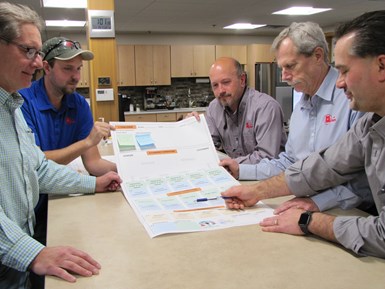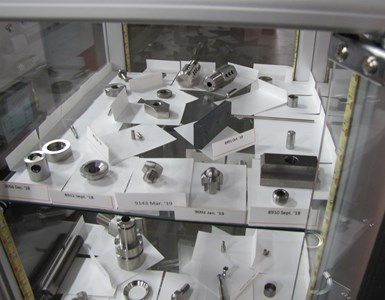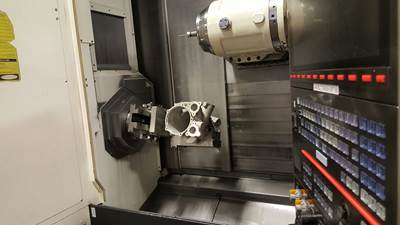Share


At Micron Manufacturing in Grand Rapids, Michigan, lean principles, continuous improvement and design for manufacturability are the three pillars of what the job shop feels are key to its “enduring reliability.” “Enduring reliability” is simply the trademarked verbiage the shop uses to summarize its goals and business practices, what Mike Preston calls a two-word mission statement. Mr. Preston, company president and founder’s son, explains that these two words signify that customers can rely on Micron to deliver parts and service with absolute confidence.
Of course, he acknowledges that every shop has similar goals and intentions. “We think our approach is not only effective, but also distinctive because we’ve worked hard to systematize it,” he says. The shop uses another trademark, “Systemicron,” as the name for this systematic approach to reliable, consistent and high-quality production.
As noted, the essence of this approach is a structured melding of three elements. The principles of lean manufacturing are the foundation. Continuous improvement is the broad operational strategy that builds on this foundation. Design for manufacturability (DFM) provides a practical play book that governs almost all of the details of job quoting, coordination of production processes, workflow and inspection.

Chris Schmidt leads a morning huddle, using the central scheduling board as a visual prompt to cover all of the day's objectives. Each member of the production team can see what needs to be done, hear suggestions and advice from other team members, and speak up about any issues that could interfere with the day’s work.
Mr. Preston says that each of these pillars requires intense concentration and discipline in its own right. “That’s why many shops have focused primarily on one of these disciplines,” he explains. “And individually, they do have substantial rewards and benefits.” However, he notes that implementing and managing all three in a unified approach is what makes the difference for Micron.
Mr. Preston grants that this three-pillared approach might seem excessively challenging, but says that it is actually otherwise. “These disciplines are mutually reinforcing, so it’s easier to promote them together. That’s how we achieve the synergies that are so effective,” he says, adding that the resulting benefits help sustain all three disciplines. “Sustaining them for the long-haul is critical to getting the most out this unified approach.”
Here’s how Micron got each of these disciplines up and running and how they work together.
Lean Is the Foundation
Micron Manufacturing got its start in 1952 as a screw machine shop. Mr. Preston's father, Ed, began with manufacturing space in the basement of a building in downtown Grand Rapids. At first, he had a number of Traub and Warner & Swasey machines that were considered very respectable in their day. Machines from Brown & Sharpe and Acme-Gridley were added later.
The elder Mr. Preston, his son recalls, ran the shop along traditional lines — perhaps paternalistically, with a top-down, centralized decision-making style. The younger Mr. Preston also recalls that his father followed several key policies that made the company more open to change and evolution than many other small shops of the era. “He was careful to keep the company in a financially stable position by avoiding risks that might jeopardize the long-term well-being of his employees,” Mr. Preston says. “He had an open-door policy and listened to people. His machinists were empowered to make parts the best way they knew, although that became a sticking point later. In short, he wanted Micron to be a good place to work.”
After several relocations, the company moved to a purpose-built facility in 1964. Two subsequent additions to this building now provide a total 30,000 square feet of shop and office space. It currently houses 19 CNC lathes, 12 of which are Citizen Swiss-type machines. One Hurco VMC is available for milling operations and utility work. The number of employees hovers around 40 on a two-shift schedule.
“And we still run three Acme-Gridley cam-operated machines for several long-running part orders,” Mr. Preston adds, noting that these machines represent not only the legacy of traditional screw machine technology, but also the heritage of loyalty to customers.
Micron entered a critical period of transition in the late 1990s, early 2000s. The elder Mr. Preston was gradually pulling away from day-to-day involvement in shop management and retired in 1999, while his son was taking over leadership duties. A few years earlier, Ed’s son-in-law, Dan Vermeesch, had come on board as a plant manager, bringing with him no preconceived ideas on how a modern screw machine company ought to be managed. “My background was in electrical engineering. Being new to this area of manufacturing, I could look at it with fresh eyes, and I saw that Micron had to change by adopting new approaches to production management.” Mr. Vermeesch says.

Bob Zimmer checks a part on the gaging station at his machine. Relevant details about this inspection routine and other aspects of processing this part are posted on the board behind his bench for review at a glance. His input on processing the part, especially if it is a first-run job, are reflected in the reference sheets posted there.
His initial focus was implementing the principles of lean manufacturing, starting with setup reduction. “We established a goal of reducing setup time by 25% in six months. All of the lean techniques we instituted were directed toward that single goal,” Mr. Vermeesch explains. For example, 5S (workspace organization and ergonomic streamlining) was put in place in the context of the overall setup reduction campaign. The help of an outside consulting firm provided expert guidance, thus avoiding any missteps.
Mike Smith, Micron’s engineering manager and a veteran of this transition, says that there was resistance to these changes at first. “Some of the changes were unpopular because they were disruptive, such as getting rid of tool chests at each machinist workstation, eliminating separate departments for different processes, and creating localized inspection stations throughout the shop to replace a central QC area,” he says.
He reports that, as expected, the benefits of these changes became apparent quickly enough to win people over. “The general change in outlook enabled us to make even bigger changes. We eliminated our secondary operations department, began outsourcing processes such as grinding, started bringing in CNC machines and established a one-piece-flow production system.”
Mr. Vermeesch says the setup reduction goal was not only met on time, but quickly exceeded. Setup time has been shrinking ever since. “Whereas at one point we were doing 96 setups in 3,000 hours on our multi-spindle machines, we now do 287 setups in about 1,000 hours.”
Shopfloor culture is built around the expectation that incremental changes that improve processes and employee performance will be ongoing and continuous.
— Dan Vermeesch
In short, by 2008, the shopfloor culture at Micron had completely changed, he says, adding that this culture is built around the expectation that incremental changes that improve processes and employee performance will be ongoing and continuous. The foundation for Systemicron was solidly in place.
High Visibility
Today, a walking tour of Micron’s shop areas reveals all of the classic hallmarks of a company well along the lean journey. These include shadowboards for hand tools; posted checklists for setup procedures, machine maintenance and housekeeping items; standardized work guidelines; and several kanban stations.
However, Micron’s approach to lean is not entirely conventional. As a job shop/contract manufacturer, the organization has adopted its own interpretation and customized implementation of lean principles.
To summarize how Mr. Preston and Mr. Vermeesch explain it, Micron’s style of lean manufacturing is characterized by an emphasis on the importance of keeping things visual and reducing variability. By “visual,” they mean keeping vital details about daily production and routine procedures available at a glance. Individually and as a group, employees can easily see what needs to be done at that moment. For example, a dry-marker scheduling board is located in a central point in the shop near the hallway to the engineering offices and conference room. This board is updated in the morning before the daily “huddle” in which machinists, schedulers and engineers review jobs in progress, jobs next in line and other action items. The huddle (usually a 5- to 10-minute session held first thing every morning) is an opportunity for the team to share suggestions, advice, concerns, warnings and any other matters that benefit from positive, collective thinking.
The term visual, however, does not mean the shop does not rely on its computer network for communication and digital applications such as scheduling and shop control with its ERP software from JobBoss. “We use software tools where the automation and processing power make sense,” Mr. Vermeesch says. “Visual representations serve as a backup to digitally processed information available online.”
A number of other marker boards and notification stations are maintained throughout the shop, with several of the most important on the walls around the table in the conference room.
Low Variability
Reducing variability is the other distinctive aspect of Systemicron’s integration of lean principles. “It’s taught us to standardize processes and procedures wherever we can,” says Brian Hoff, QC manager. “Doing things the same way brings efficiency, consistency and predictability. Reducing variability helps us minimize mistakes, scrap and rework or any other unexpected result.”
Reducing variability also is the principle that integrates lean principles with Micron’s approach to DFM.
“Design for manufacturability usually refers to a method to make an initial part design suitable for efficient or optimal manufacturing processes,” Mr. Hoff explains. “But as a job shop, we come in after a part has been designed and engineered by a potential customer.” He says there are still substantial and critical opportunities to influence the manufacturability of parts submitted in a request for quote (RFQ). “We control what we can to the extent that we stay within our standardization efforts.”

Mike Preston (far left) and Dan Vermeesch (far right) go over a Kata template, which analyzes routine procedures such as machine setup to discern patterns that can lead to continuous improvement as an ingrained habit. Alex Puff, Brian Hoff and Mike Smith (left to right) are there to join in the discussion.
The shop does this by carefully evaluating RFQs from new and existing customers. Alex Puff, who has worked alongside Mike Smith on the engineering staff, says that the goal of this evaluation process is to determine if the part — and the potential customer — are a good fit for Micron. “A good fit indicates that making the part and working with this customer will not require us to move too far away from our way of doing things.”
The primary tools for evaluating a part and the customer are paper worksheets designed to record, quantify and summarize all essential details required to make good decisions about the best way the shop can make the part. Mr. Puff emphasizes that evaluating the customer is as important as evaluating the part at this stage of the quoting process. Mr. Preston reaffirms this point noting that “We are in business to satisfy customers. Being able to satisfy customers depends on building the right relationship with each one. How to make the part in a way that brings the best value to the customer has to be determined in the context of that relationship,” he says.
Mr. Puff says that the process begins by looking at the customer’s part. “We evaluate it in two steps, which literally are conducted on two sides of a single paper sheet.” The first side is the RFQ worksheet. The top portion captures information about the part extracted from the customer’s RFQ, which usually consists of an email message and attached CAD files. This portion is followed by a list of operations likely needed to complete the part, with boxes for rating the operation’s difficulty, specifying its setup requirements, determining tooling needs and other considerations. At the bottom of the form, a place is given for the longest lead time (in working days) until the part can be delivered. Exceptions and notes are added in remaining space on the form.
The other side of the sheet is the Quote Feasibility Commitment questionnaire. The top half of the form lists 18 questions formulated to cover all aspects of job flow and processing (as opposed to technical part production covered on the opposite side). Considering each question is intended to identify risks. These are any aspect of the part that might force the shop to vary its usual procedures and practices. Examining each issue closely helps the entire production team find creative ways to accommodate exceptions as much as possible.
In many cases, we can see clearly that the part is not a fit for Micron. We do not hesitate to pass on these RFQs. — Alex Puff
Quotes are submitted for parts that are determined to be feasible for production without revision. Parts determined to be feasible if the customer can agree to recommended changes are returned to the Micron sales representative for consultation with the customer. Parts determined not feasible without a design revision are not quoted until Micron engineers can confer with the customer’s engineers. “In many cases, we can see clearly that the part is not a fit for Micron. We do not hesitate to pass on these RFQs.” Mr. Puff says.
Find a Good Fit
Just as parts are evaluated for a good fit, customers are also evaluated for a good fit. Micron’s sales manager uses another questionnaire called the Perfect Customer Calculator (PPCalc) for this. It requires the sales manager to interview the customer on 18 queries about payment terms, accessibility to the customer’s engineers and design team, incoming part inspection routines and so on. In the end, customers are rated A (best fit), B (close fit) or F (no fit). “The intent is to identify customers with which we can build a long-term relationship that values the enduring reliability Systemicron is designed to provide,” Mr. Preston explains. Mr. Vermeesch adds that the PCCalc rating formula brings some objectivity and consistency to this process. “It’s not meant to be exclusive or unduly restrictive. We want to have a broad customer base, but a stable one,” he says.
The PPCalc rating is the first item entered on the Quote Feasibility Commitment worksheet. This is significant. Mr. Puff says that Micron wants to do business with A-rated customers, so the feasibility issues uncovered on this form get special attention. “If we can stretch our capabilities or find the flexibility to accommodate their needs, we are willing to make that effort,” he says. And this, he adds, gets back to continuous improvement. “It’s not just about better numbers such as faster cycle times, quicker setups, fewer rejects and so on. It is about changing in ways that help us deliver greater value to customers. We want to maximize, by design, what is manufacturable here,” he concludes.
Not to be overlooked are two other policies that Micron follows to establish and maintain good customer relations. One is producing a sample part that can be sent to the customer with the quote. The part is available usually within two days after receiving the RFQ. This practice is a test of the proposed process plan as well as physical proof of the part’s feasibility. “This uncovers the unexpected and takes out the guesswork,” Mr. Vermeesch says. “Every sample is a valuable learning experience because we document the entire process as part of our continuous improvement habits.”
The second policy is to encourage a shop tour by the customer’s key personnel. “The face-to-face contact builds trust on both sides. Equally important is seeing and talking to machine operators, inspectors, engineers — everyone on the team. We have good processes, but having good people makes the difference,” Mr. Preston says. He reports that since 2002, Micron has hosted dozens of plant tours with customers and hundreds of tours for schools, community groups, government leaders and other manufacturing companies, including competitors.
Once a quote is accepted, Micron follows other standardized agendas or templates for meetings and huddles to keep the entire team, literally, on the same page. For example, a New Project Launch form outlines the agendas for a new product kick-off meeting, a pre-engineering checklist and a general new product launch meeting. Required attendees are specified, along with critical items that must be covered and resolved in each meeting.
Evaluation forms must be completed, reviewed and signed by individuals representing each of the disciplines involved before the finished quote is submitted.
When a job is completed, the shop follows similarly standardized agendas for “Out Brief” meetings. These begin no later than two days after the parts are shipped, when notes and ideas for process improvements, troubleshooting or opportunities for better decision-making are still fresh. “Capturing these ideas, posting them for action and rewarding their completion keeps us on the right path,” Mr. Puff says.
Results of each Out Brief meeting are organized and recorded on standardized report forms and attached to the appropriate board in the conference room. According to Mr. Puff, this makes it convenient for teams representing quality assurance, safety, programming, engineering or production to circulate from board to board on a regularly scheduled basis. Items are initialed by the individuals taking responsibility and initialed again when completed or handed off for further action.
Can Micron Endure Reliably?
This question is one way to express what Mr. Preston and Mr. Vermeesch consider their top responsibility. “It is up to us to be sure that this company can continue to meet changing market conditions and evolving customer demands,” Mr. Preston says. Mr. Vermeesch puts it another way: “Lean principles, continuous improvement and design for manufacturability as they have been uniquely adopted and blended here give us a momentum to move forward. We believe that what we call Systemicron is sustainable and that it can ensure the company’s sustainability.”

Sample parts made for customers are informally displayed in a glass case right inside the main entrance to the shop area. The array of samples hints at the variety of work at Micron, as well as attests to the shop's responsiveness to customer requirements.
Both gentlemen agree that fulfilling the commitment to the enduring reliability that customers expect answers the question about the company’s ability to compete and prevail. As they see it, the strength of Systemicron is in channeling and unifying the efforts of everyone in the company toward fulfilling this commitment.
Currently, Micron is studying its options for a machine monitoring and data collection system, and the company is going about it in a characteristically original way. According to Mr. Vermeesch, a pilot program is having selected machine operators collect and record data about their procedures and machine performance. They simply use reporting forms to write down minutes spent on aspects of setup, reasons for downtime, how long the downtime lasted and details about other machine events or their activities. This information is being tabulated in a simple database, then analyzed, usually with the mathematical calculations capable in spreadsheet software.
“We know that monitoring systems can capture a great amount of data. We’d rather know what data is the most useful to us first, then evaluate systems by their ability to gather and process that data,” Mr. Vermeesch explains. “We’re looking for a system that primarily helps machine operators make better decisions with some automated data collection. We don’t have the kind of management structure for which data analysis and reporting is urgently needed,” he says, admitting that he might be underestimating the benefits of machine monitoring. “We’re approaching this with open minds.”
Ultimately, Mr. Vermeesch sees machine monitoring reinforcing and enhancing what Systemicron already accomplishes, and, as he says, “The pillars of reliable productivity are in place.”
Related Content
Lessons From a Lean Shop
This custom ring manufacturer puts effort into Kaizen principles that help it to produce custom works of art at a high volume while spending minimal work on administrative duties.
Read MoreHow To (Better) Make a Micrometer
How does an inspection equipment manufacturer organize its factory floor? Join us as we explore the continuous improvement strategies and culture shifts The L.S. Starrett Company is implementing across the over 500,000 square feet of its Athol, Massachusetts, headquarters.
Read MoreRead Next
DFM in the Glass Hut
For this company, the collaboration between engineering and manufacturing is physically represented by the “glass hut,” the so-named conference room with a clear view of the shop floor.
Read MoreManaging Change in a CNC Machine Shop
The practice of continuous improvement in machine shops should be ongoing. But is there a tipping point at which constant change becomes counterproductive?
Read More10 Lean Manufacturing Ideas for Machine Shops
In addition to the right mix of traditional strategies, a lean manufacturing toolkit can make high-mix, low-volume machining faster, more predictable and less expensive.
Read More

























